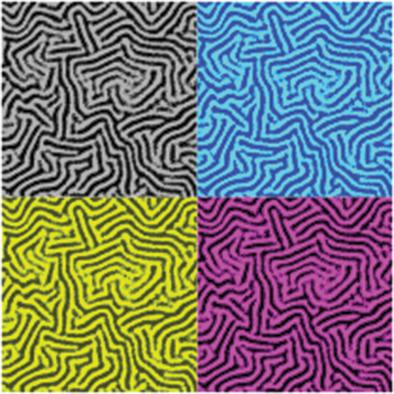当前位置:
X-MOL 学术
›
Adv. Mater.
›
论文详情
Our official English website, www.x-mol.net, welcomes your feedback! (Note: you will need to create a separate account there.)
Laser Generation of Sub-Micrometer Wrinkles in a Chalcogenide Glass Film as Physical Unclonable Functions.
Advanced Materials ( IF 29.4 ) Pub Date : 2020-08-06 , DOI: 10.1002/adma.202003032 Paloma Martinez 1 , Irene Papagiannouli 1 , Dominique Descamps 1 , Stéphane Petit 1 , Joël Marthelot 2 , Anna Lévy 3 , Baptiste Fabre 1 , Jean-Baptiste Dory 4 , Nicolas Bernier 4 , Jean-Yves Raty 4, 5 , Pierre Noé 4 , Jérôme Gaudin 1
Advanced Materials ( IF 29.4 ) Pub Date : 2020-08-06 , DOI: 10.1002/adma.202003032 Paloma Martinez 1 , Irene Papagiannouli 1 , Dominique Descamps 1 , Stéphane Petit 1 , Joël Marthelot 2 , Anna Lévy 3 , Baptiste Fabre 1 , Jean-Baptiste Dory 4 , Nicolas Bernier 4 , Jean-Yves Raty 4, 5 , Pierre Noé 4 , Jérôme Gaudin 1
Affiliation

|
Laser interaction with solids is routinely used for functionalizing materials' surfaces. In most cases, the generation of patterns/structures is the key feature to endow materials with specific properties like hardening, superhydrophobicity, plasmonic color‐enhancement, or dedicated functions like anti‐counterfeiting tags. A way to generate random patterns, by means of generation of wrinkles on surfaces resulting from laser melting of amorphous Ge‐based chalcogenide thin films, is presented. These patterns, similar to fingerprints, are modulations of the surface height by a few tens of nanometers with a sub‐micrometer periodicity. It is shown that the patterns' spatial frequency depends on the melted layer thickness, which can be tuned by varying the impinging laser fluence. The randomness of these patterns makes them an excellent candidate for the generation of physical unclonable function tags (PUF‐tags) for anti‐counterfeiting applications. Two specific ways are tested to identify the obtained PUF‐tag: cross‐correlation procedure or using a neural network. In both cases, it is demonstrated that the PUF‐tag can be compared to a reference image (PUF‐key) and identified with a high recognition ratio on most real application conditions. This paves the way to straightforward non‐deterministic PUF‐tag generation dedicated to small sensitive parts such as, for example, electronic devices/components, jewelry, or watchmak.
中文翻译:

激光在亚硫族化物玻璃膜中产生的亚微米皱纹是物理上不可克隆的功能。
激光与固体的相互作用通常用于功能化材料表面。在大多数情况下,图案/结构的生成是赋予材料特殊属性(如硬化,超疏水性,等离激元色彩增强)或专用功能(如防伪标签)的关键特征。提出了一种通过在非晶态的基于锗的硫族化物薄膜进行激光熔化而在表面上产生皱纹的方式来产生随机图案的方法。这些图案类似于指纹,是亚微米周期的几十纳米的表面高度调制。结果表明,图案的空间频率取决于熔化层的厚度,可以通过改变撞击的激光通量来对其进行调整。这些模式的随机性使其成为防伪应用中物理不可克隆功能标签(PUF标签)生成的极佳候选者。测试了两种特定方法来识别获得的PUF标签:互相关过程或使用神经网络。在这两种情况下,都证明了可以将PUF标签与参考图像(PUF键)进行比较,并在大多数实际应用条件下以较高的识别率进行识别。这为专门用于小型敏感零件(例如,电子设备/组件,珠宝或手表)的直接非确定性PUF标签生成铺平了道路。互相关过程或使用神经网络 在这两种情况下,都证明了可以将PUF标签与参考图像(PUF键)进行比较,并在大多数实际应用条件下以较高的识别率进行识别。这为专门用于小型敏感零件(例如,电子设备/组件,珠宝或手表)的直接非确定性PUF标签生成铺平了道路。互相关过程或使用神经网络 在这两种情况下,都证明了可以将PUF标签与参考图像(PUF键)进行比较,并在大多数实际应用条件下以较高的识别率进行识别。这为专门用于小型敏感零件(例如,电子设备/组件,珠宝或手表)的直接非确定性PUF标签生成铺平了道路。
更新日期:2020-09-21
中文翻译:

激光在亚硫族化物玻璃膜中产生的亚微米皱纹是物理上不可克隆的功能。
激光与固体的相互作用通常用于功能化材料表面。在大多数情况下,图案/结构的生成是赋予材料特殊属性(如硬化,超疏水性,等离激元色彩增强)或专用功能(如防伪标签)的关键特征。提出了一种通过在非晶态的基于锗的硫族化物薄膜进行激光熔化而在表面上产生皱纹的方式来产生随机图案的方法。这些图案类似于指纹,是亚微米周期的几十纳米的表面高度调制。结果表明,图案的空间频率取决于熔化层的厚度,可以通过改变撞击的激光通量来对其进行调整。这些模式的随机性使其成为防伪应用中物理不可克隆功能标签(PUF标签)生成的极佳候选者。测试了两种特定方法来识别获得的PUF标签:互相关过程或使用神经网络。在这两种情况下,都证明了可以将PUF标签与参考图像(PUF键)进行比较,并在大多数实际应用条件下以较高的识别率进行识别。这为专门用于小型敏感零件(例如,电子设备/组件,珠宝或手表)的直接非确定性PUF标签生成铺平了道路。互相关过程或使用神经网络 在这两种情况下,都证明了可以将PUF标签与参考图像(PUF键)进行比较,并在大多数实际应用条件下以较高的识别率进行识别。这为专门用于小型敏感零件(例如,电子设备/组件,珠宝或手表)的直接非确定性PUF标签生成铺平了道路。互相关过程或使用神经网络 在这两种情况下,都证明了可以将PUF标签与参考图像(PUF键)进行比较,并在大多数实际应用条件下以较高的识别率进行识别。这为专门用于小型敏感零件(例如,电子设备/组件,珠宝或手表)的直接非确定性PUF标签生成铺平了道路。



























 京公网安备 11010802027423号
京公网安备 11010802027423号